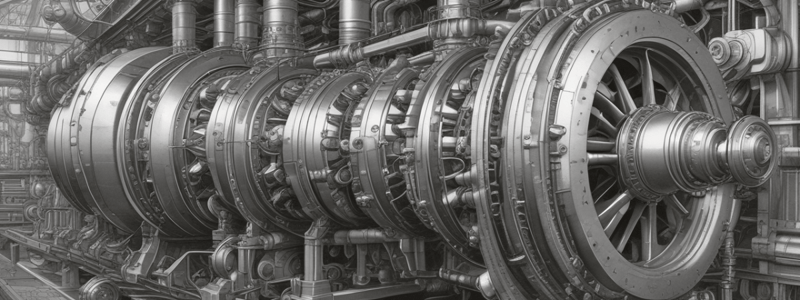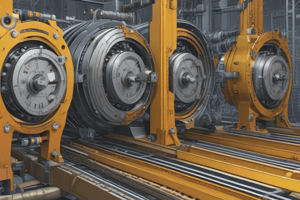Podcast
Questions and Answers
What is the primary function of a tachometer?
What is the primary function of a tachometer?
- To convert rotational speed into an electrical signal (correct)
- To monitor the temperature of electrical equipment
- To regulate the speed of industrial machinery
- To measure vibration in mechanical systems
Which type of tachometer is suitable for industrial machinery and automation systems?
Which type of tachometer is suitable for industrial machinery and automation systems?
- Mechanical Type Tachometer
- Stroboscope
- Electrical Type Tachometer (correct)
- Digital Tachometer
What is the principle of operation of a stroboscope?
What is the principle of operation of a stroboscope?
- It emits flashes of light at adjustable frequencies (correct)
- It uses electronic sensors to measure rotational speed
- It converts rotational speed into a DC voltage
- It measures vibration using a seismic mass
What is the main advantage of using seismic accelerometers?
What is the main advantage of using seismic accelerometers?
What is the purpose of a strain gauge in a strain gauge accelerometer?
What is the purpose of a strain gauge in a strain gauge accelerometer?
Which type of accelerometer is commonly used in structural health monitoring?
Which type of accelerometer is commonly used in structural health monitoring?
What is the primary application of a digital tachometer?
What is the primary application of a digital tachometer?
What is the main disadvantage of seismic accelerometers?
What is the main disadvantage of seismic accelerometers?
What is the purpose of a commutator in a DC tachometer generator?
What is the purpose of a commutator in a DC tachometer generator?
What is the primary use of vibration measurement in mechanical engineering?
What is the primary use of vibration measurement in mechanical engineering?
What is the main purpose of speed measurement in mechanical engineering applications?
What is the main purpose of speed measurement in mechanical engineering applications?
Which type of tachometer uses centrifugal force to measure rotational speed?
Which type of tachometer uses centrifugal force to measure rotational speed?
What is the principle of operation of a chronometric tachometer?
What is the principle of operation of a chronometric tachometer?
What is the application of a vibrating reed tachometer?
What is the application of a vibrating reed tachometer?
Which of the following is not a type of tachometer?
Which of the following is not a type of tachometer?
What is the component of a centrifugal tachometer that moves outward against the spring force?
What is the component of a centrifugal tachometer that moves outward against the spring force?
What is the principle of operation of a vibrating reed tachometer?
What is the principle of operation of a vibrating reed tachometer?
What is measured by a chronometric tachometer?
What is measured by a chronometric tachometer?
What is the application of a centrifugal tachometer?
What is the application of a centrifugal tachometer?
Which type of measurement is done using seismic, strain gauge, and piezoelectric accelerometers?
Which type of measurement is done using seismic, strain gauge, and piezoelectric accelerometers?
What is the primary function of the core in a Linear Variable Differential Transformer (LVDT)?
What is the primary function of the core in a Linear Variable Differential Transformer (LVDT)?
What is the main advantage of using an LVDT over other displacement measurement methods?
What is the main advantage of using an LVDT over other displacement measurement methods?
What is the operating principle of a Light Dependent Resistor (LDR)?
What is the operating principle of a Light Dependent Resistor (LDR)?
What is the main disadvantage of using a Capacitive Pick-up?
What is the main disadvantage of using a Capacitive Pick-up?
What is the primary application of Inductive Pick-ups?
What is the primary application of Inductive Pick-ups?
What is the main advantage of using an LVDT over an LDR?
What is the main advantage of using an LVDT over an LDR?
What is the operating principle of a Capacitive Pick-up?
What is the operating principle of a Capacitive Pick-up?
What is the main disadvantage of using an LVDT?
What is the main disadvantage of using an LVDT?
What is the primary application of an LDR?
What is the primary application of an LDR?
What is the main advantage of using a Capacitive Pick-up over an Inductive Pick-up?
What is the main advantage of using a Capacitive Pick-up over an Inductive Pick-up?
What is the primary function of a Wheatstone Bridge Circuit in an accelerometer?
What is the primary function of a Wheatstone Bridge Circuit in an accelerometer?
What is the main advantage of piezoelectric accelerometers?
What is the main advantage of piezoelectric accelerometers?
What is the primary application of seismic accelerometers?
What is the primary application of seismic accelerometers?
What is the principle of linear variable differential transformers (LVDTs)?
What is the principle of linear variable differential transformers (LVDTs)?
What is the main advantage of strain gauge accelerometers?
What is the main advantage of strain gauge accelerometers?
What is the primary application of linear displacement resistors (LDRs)?
What is the primary application of linear displacement resistors (LDRs)?
What is the principle of angular displacement measurement?
What is the principle of angular displacement measurement?
What is the primary application of rotary encoders?
What is the primary application of rotary encoders?
What is the primary disadvantage of piezoelectric accelerometers?
What is the primary disadvantage of piezoelectric accelerometers?
What is the primary application of inductive pick-ups?
What is the primary application of inductive pick-ups?
Study Notes
Speed Measurements in Mechanical Engineering
- Speed measurement is essential in various mechanical engineering applications to monitor and control the rotational speed of machines, engines, and other mechanical systems.
- Different types of tachometers (mechanical and electrical) and stroboscopes are used for speed measurement.
Mechanical Type Tachometers
- Centrifugal Tachometer: uses centrifugal force to measure rotational speed; components: weighted arms, spring, and scale; applications: older machinery, educational demonstrations.
- Chronometric Tachometer: measures speed based on time interval between successive pulses; components: rotating element, timing mechanism, and dial; applications: vintage vehicles, historical equipment.
- Vibrating Reed Tachometer: uses resonance frequency of vibrating reeds to measure rotational speed; components: set of reeds, each tuned to resonate at a specific frequency; applications: portable speed measurement, industrial equipment.
Electrical Type Tachometers
- DC Tachometer Generator: converts rotational speed to a DC voltage; components: permanent magnet, armature winding, commutator, brushes; applications: industrial machinery, automation systems.
- AC Tachometer Generator: converts rotational speed to an AC voltage; components: rotor, stator windings; applications: motors, generators, speed control systems.
- Digital Tachometer: uses electronic sensors to measure rotational speed and display it digitally; components: optical or magnetic sensors, microprocessor, digital display; applications: modern machinery, automotive diagnostics, laboratory equipment.
Stroboscope
- Uses a flashing light to make a rotating or vibrating object appear stationary, allowing for measurement of its speed; components: light source, control unit, and viewing area; applications: rotational speed measurement, vibration analysis, machinery maintenance.
Vibration Measurements in Mechanical Engineering
- Vibration measurement is crucial in various mechanical engineering applications, including machinery health monitoring, structural analysis, and quality control.
- Different types of accelerometers (seismic, strain gauge, and piezoelectric) are used to measure vibrations.
Seismic Accelerometers
- Measure vibration by detecting the relative motion between a mass and its housing; components: seismic mass, spring/damper system, and transducer; advantages: simple construction, robust, and reliable; disadvantages: limited frequency range, affected by temperature changes; applications: structural health monitoring, earthquake detection, low-frequency vibration measurement.
Strain Gauge Accelerometers
- Measure vibration by detecting the strain in a material caused by acceleration forces; components: strain gauges, flexible element, and Wheatstone bridge circuit; advantages: high sensitivity, suitable for low-frequency vibrations; disadvantages: limited dynamic range, sensitive to temperature variations; applications: structural testing, machinery health monitoring, aerospace applications.
Piezoelectric Accelerometers
- Measure vibration by converting mechanical stress into an electrical charge using piezoelectric materials; components: piezoelectric crystal, seismic mass, and charge amplifier; advantages: wide frequency range, high sensitivity and stability, good temperature stability; disadvantages: requires charge amplifier or signal conditioner, may be affected by base strain and thermal transients; applications: machinery condition monitoring, modal analysis, vibration testing in automotive and aerospace industries.
Displacement Measurements in Mechanical Engineering
- Displacement measurements are essential in various mechanical engineering applications to monitor and control the position, movement, and alignment of components.
- These measurements can be linear or angular, and several types of sensors are used to measure displacement accurately.
Linear Displacement Measurements
- Rulers and Vernier Calipers: simple mechanical devices for direct measurement; applications: precision machining, material testing, structural deformation monitoring.
- Dial Indicators: mechanical devices for precise measurement of small linear displacements; applications: precision machining, material testing.
- Linear Variable Differential Transformers (LVDTs): sensors that provide accurate and continuous measurement; applications: precision measurement in laboratory and industrial settings, aerospace and automotive testing, material testing machines.
Angular Displacement Measurements
- Protractors and Angle Gauges: simple mechanical devices for direct measurement; applications: robotics, machine tool alignment, automotive steering systems.
- Rotary Encoders: electronic devices for precise measurement; applications: robotics, machine tool alignment.
- Inductive and Capacitive Pick-ups: sensors that provide accurate and continuous measurement; applications: robotics, machine tool alignment, automotive steering systems.
Linear Variable Differential Transformer (LVDT)
- Measures linear displacement using the variation in inductance; components: primary coil, secondary coils, and core; advantages: high accuracy and sensitivity, no physical contact between the core and coils, long life and reliability; disadvantages: sensitive to temperature variations, requires an AC power source; applications: precision measurement in laboratory and industrial settings, aerospace and automotive testing, material testing machines.
Light Dependent Resistor (LDR)
- Measures displacement based on changes in light intensity and corresponding changes in resistance; components: LDR sensor, light source, and moving object; advantages: simple and inexpensive, non-contact measurement; disadvantages: sensitive to ambient light variations, limited accuracy and resolution; applications: position sensing in robotics, light-sensitive switches, basic displacement measurements.
Capacitive Pick-ups
- Measure displacement by detecting changes in capacitance between two conductive plates; components: conductive plates, dielectric medium, and electronics; advantages: high sensitivity and resolution, suitable for small displacement measurements, non-contact measurement; disadvantages: sensitive to environmental changes (e.g., humidity, temperature), requires precise alignment; applications: micro-electromechanical systems (MEMS), precision positioning in semiconductor manufacturing, gap measurement in machinery.
Inductive Pick-ups
- Measure displacement by detecting changes in inductance; components: coil and core; applications: precision measurement, gap measurement in machinery.
Studying That Suits You
Use AI to generate personalized quizzes and flashcards to suit your learning preferences.
Description
This quiz covers various measurement techniques in mechanical engineering, including speed, vibration, and displacement measurements using different types of tachometers, accelerometers, and pick ups.





